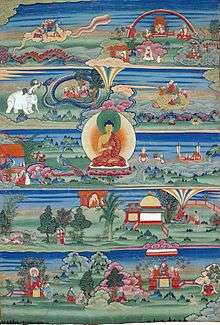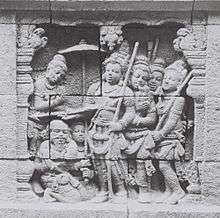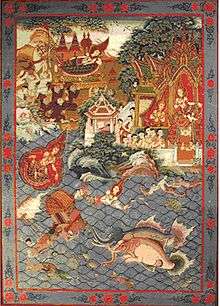Jataka tales
The Jātaka tales are a voluminous body of literature native to India concerning the previous births of Gautama Buddha in both human and animal form. The future Buddha may appear as a king, an outcast, a god, an elephant—but, in whatever form, he exhibits some virtue that the tale thereby inculcates.[1] Often, Jātaka tales include an extensive cast of characters who interact and get into various kinds of trouble - whereupon the Buddha character intervenes to resolve all the problems and bring about a happy ending.

| Translations of Jātaka tales | |
|---|---|
| English | Birth history |
| Sanskrit | जातक (Jātaka) |
| Burmese | ဇာတက |
| Khmer | ជាតក (Cheadok) |
| Glossary of Buddhism | |
| Part of a series on |
| Buddhism |
|---|
 |
|
|
|
In Theravada Buddhism, the Jātakas are a textual division of the Pāli Canon, included in the Khuddaka Nikaya of the Sutta Pitaka. The term Jātaka may also refer to a traditional commentary on this book. The tales are dated between 300 BC and 400 AD.[2]
History Mahāsāṃghika Caitika sects from the Āndhra region took the Jātakas as canonical literature and are known to have rejected some of the Theravāda Jātakas which dated past the time of King Ashoka .[3] The Caitikas claimed that their own Jātakas represented the original collection before the Buddhist tradition split into various lineages.[4]
According to A. K. Warder, the Jātakas are the precursors to the various legendary biographies of the Buddha, which were composed at later dates.[5] Although many Jātakas were written from an early period, which describe previous lives of the Buddha, very little biographical material about Gautama's own life has been recorded.[5]
The Jātaka-Mālā of Arya Śura in Sanskrit gives 34 Jātaka stories.[6] At the Ajanta Caves, Jātaka scenes are inscribed with quotes from Arya Shura,[7] with script datable to the sixth century. It had already been translated into Chinese in 434 CE. Borobudur contains depictions of all 34 Jatakas from Jataka Mala.[8]

Contents
The Theravāda Jātakas comprise 547 poems, arranged roughly by an increasing number of verses. According to Professor von Hinüber,[9] only the last 50 were intended to be intelligible by themselves, without commentary. The commentary gives stories in prose that it claims provide the context for the verses, and it is these stories that are of interest to folklorists. Alternative versions of some of the stories can be found in another book of the Pali Canon, the Cariyapitaka, and a number of individual stories can be found scattered around other books of the Canon. Many of the stories and motifs found in the Jātaka such as the Rabbit in the Moon of the Śaśajātaka (Jataka Tales: no.316),[10] are found in numerous other languages and media. For example, The Monkey and the Crocodile, The Turtle Who Couldn't Stop Talking and The Crab and the Crane that are listed below also famously featured in the Hindu Panchatantra, the Sanskrit niti-shastra that ubiquitously influenced world literature.[11] Many of the stories and motifs are translations from the Pali but others are instead derived from vernacular oral traditions prior to the Pali compositions.[12]

Sanskrit (see for example the Jātakamālā) and Tibetan Jātaka stories tend to maintain the Buddhist morality of their Pali equivalents, but re-tellings of the stories in Persian and other languages sometimes contain significant amendments to suit their respective cultures. At the Mahathupa in Sri Lanka all 550 Jataka tales were represented inside of the reliquary chamber.[13] Reliquaries often depict the Jataka tales.
Jātaka stupas
Many stupas in northern India are said to mark locations from the Jātaka tales; the Chinese pilgrim Xuanzang reported several of these. A stupa in Pushkalavati, in northwestern Pakistan, marks where Syama fulfilled his filial duty to his blind parents. The Mankiala stupa near Gujar Khan commemorates the spot where Prince Sattva sacrificed himself to feed baby tigers.[14] Nearby the ascetic Ekasrnga was seduced by a beautiful woman. In Mangalura, Ksantivadin submitted to mutilation by a king. At Hadda Mountain a young Brahmin sacrificed himself to learn a half verse of the dharma. At Sarvadattaan an incarnation sold himself for ransom to make offerings to a Brahmin.[15]
Faxian describes the four great stupas as being adorned with precious substances. At one site king Sibi sacrifices his flesh to ransom a dove from a hawk. Another incarnation gave up his eyes when asked; a third incarnation sacrificed his body to feed a hungry tigress. As King Candraprabha he cut off his head as a gift to a Brahmin.[16] Some would sever their body parts in front of stupas that contained relics; or even end their own lives.
Apocrypha
Within the Pali tradition, there are also many apocryphal Jātakas of later composition (some dated even to the 19th century) but these are treated as a separate category of literature from the "Official" Jātaka stories that have been more or less formally canonized from at least the 5th century — as attested to in ample epigraphic and archaeological evidence, such as extant illustrations in bas relief from ancient temple walls.
Apocryphal Jātakas of the Pali Buddhist canon, such as those belonging to the Paññāsa Jātaka collection, have been adapted to fit local culture in certain South East Asian countries and have been retold with amendments to the plots to better reflect Buddhist morals.[17][18]
Celebrations and ceremonies
In Theravada countries several of the longer tales such as "The Twelve Sisters"[19] and the Vessantara Jataka[20] are still performed in dance,[21] theatre, and formal (quasi-ritual) recitation.[22] Such celebrations are associated with particular holidays on the lunar calendar used by Thailand, Myanmar, Sri Lanka and Laos.
Translations
The standard Pali collection of jātakas, with canonical text embedded, has been translated by E. B. Cowell and others, originally published in six volumes by Cambridge University Press, 1895-1907; reprinted in three volumes, Pali Text Society,[23] Bristol. There are also numerous translations of selections and individual stories from various languages.
The Jātaka-Mālā of Arya Śura was critically edited in the original Sanskrit [Nâgarî letters] by Hendrik Kern of the University of Leiden in Netherlands, which was published as volume 1 of the Harvard Oriental Series in 1891. A second issue came in 1914.
List of Jātakas
This list includes stories based on or related to the Jātakas:
- The Ass in the Lion's Skin (Sīhacamma Jātaka)
- The Banyan Deer
- The Cock and the Cat (Kukkuṭa Jātaka)
- The Crab and the Crane
- The Elephant Girly-Face
- The Monkey King (Mahakapi Jataka)
- The Foolish, Timid Rabbit (Daddabha Jātaka)
- Four Harmonious Animals
- The Great Ape
- How the Turtle Saved His Own Life
- The Jackal the Crow (Jambu-Khādaka Jātaka)
- The Jackal and the Otters (Dabbhapuppha Jātaka)
- The King's White Elephant
- The Lion and the Woodpecker (Javasakuṇa Jātaka)
- The Measure of Rice
- The Merchant of Seri
- The Monkey and the Crocodile
- The Ox Who Envied the Pig (Muṇika-Jātaka)
- The Ox Who Won the Forfeit
- The story of Romaka pigeon (Romaka Jātaka, previous life of the Buddha as a pigeon).[24]
- Prince Sattva
- The Princes and the Water-Sprite
- The Quarrel of the Quails
- The Swan with Golden Feathers (Suvaṇṇahaṃsa Jātaka)
- King Sibi
- King Dasharatha
- The Tiger, the Brahmin and the Jackal
- The Turtle Who Couldn't Stop Talking (Kacchapa Jātaka)
- The Twelve Sisters
- The Wise and the Foolish Merchant
- Vessantara Jataka
- Why the Owl Is Not King of the Birds
See also
References
- "Jataka". Encyclopædia Britannica. Retrieved 2011-12-04.
- https://web.archive.org/web/20191005233546/https://www.pitt.edu/~dash/jataka.html
- Sujato, Bhante (2012), Sects & Sectarianism: The Origins of Buddhist Schools, Santipada, p. 51, ISBN 9781921842085
- Warder, A.K. Indian Buddhism. 2000. pp. 286-287
- Warder, A.K. Indian Buddhism. 2000. pp. 332-333
- THE JATAKA-MALA Stories of Buddha's former Incarnations OTHERWISE ENTITLED BODHISATTVA-AVADANA-MALA By ARYA-ŚURA CRITICALLY EDITED IN THE ORIGINAL SANSKRITu7 BY DR. HENDRIK KERN, https://archive.org/details/jatakamala015656mbp
- Literary History of Sanskrit Buddhism: From Winternitz, Sylvain Levi, Huber, By Gushtaspshah K. Nariman, Moriz Winternitz, Sylvain Lévi, Edouard Huber, Motilal Banarsidass Publ., 1972 p. 44
- Jataka/Avadana Stories — Table of Contents "Archived copy". Archived from the original on 2005-12-22. Retrieved 2005-12-22.CS1 maint: archived copy as title (link)
- Handbook of Pali Literature, Walter de Gruyter, Berlin, 1996
- Source: sacred-texts.com (accessed: Saturday January 23, 2010)
- Jacobs 1888, Introduction, page lviii "What, the reader will exclaim, "the first literary link [1570] between India and England, between Buddhism and Christendom, written in racy Elizabethan with vivacious dialogue, and something distinctly resembling a plot. . . ."
- "Indian Stories",The History of World Literature, Grant L. Voth, Chantilly, VA, 2007
- (John Strong 2004, p. 51)
- Bernstein, Richard (2001). Ultimate Journey: Retracing the Path of an Ancient Buddhist Monk who Crossed Asia in Search of Enlightenment. A.A. Knopf. ISBN 9780375400094. Retrieved 16 June 2017.
- (John Strong 2004, p. 52)
- (John Strong 2004, p. 53)
- "The Tale of Prince Samuttakote: A Buddhist Epic from Thailand". Ohio University Center for International Studies. July 2, 1993 – via Google Books.
- http://www.khamkoo.com/uploads/9/0/0/4/9004485/the_tham_vessantara_jataka_-_a_critical_study_of_the_vj_and_its_influence_on_kengtung_buddhism_eastern_shan_state.pdf
- "Nang Sip Song Prarath Meri". Archived from the original on October 5, 2013.
- "Dance Troupe Prepares for Smithsonian Performance". Archived from the original on 2011-01-26. Retrieved 2011-09-17.
- "Account Suspended". www.petchprauma.com.
- Rev. Sengpan Pannyawamsa, Recital of the Tham Vessantara Jātaka: a social-cultural phenomenon in Kengtung, Eastern Shan State, Myanmar, Institute of Pali and Buddhist Studies, (University of Kelaniya), Sri Lanka
- "Pali Text Society Home Page". www.palitext.com.
- Quintanilla, Sonya Rhie (2007). History of Early Stone Sculpture at Mathura, ca. 150 BCE - 100 CE. BRILL. p. 226. ISBN 978-90-474-1930-3.
Sources
- John Strong (2004). Relics of the Buddha. Princeton University Press. ISBN 0-691-11764-0.CS1 maint: ref=harv (link)
Further reading
- Cowell, E.B.; ed. (1895). "The Jataka or Stories of the Buddha's Former Births, Vol.1-6, Cambridge at the University Press. Vol. 1, vol. 2, vol. 3, vol. 6
- Francis, Henry Thomas (1916). Jātaka tales, Cambridge: University Press
- Gaffney, Sean (2018) sKyes pa rabs kyi gleṅ gźi (Jātakanidāna): a critical edition based on six editions of the Tibetan bKa' 'gyur. Indica et Buddhica Jātakanidāna, vol. I. Oxford: Indica et Buddhica. ISBN 978-0-473-44462-4 (Open Access PDF).
- Gaffney, Sean (2019) sKyes pa rabs kyi gleṅ gźi (Jātakanidāna): Prologue to the Birth Stories: an English translation of a critical edition based on six editions of the Tibetan bKa' 'gyur. Indica et Buddhica Jātakanidāna, vol. II. Oxford: Indica et Buddhica. ISBN 978-0-473-50261-4 (Open Access PDF).
- Grey, Leslie (1990). Concordance of Buddhist Birth Stories, Oxford : Pali Text Society. (Tabulates correspondences between various jataka collections)
- Horner, Isaline Blew; Jaini, Padmanabh S. (1985). Apocryphal Birth-stories (Paññāsa-Jātaka), London ; Boston: Pali Text Society, distributed by Routledge & Kegan Paul. ISBN 9780860132332
- Jacobs, Joseph (1888), The earliest English version of the Fables of Bidpai, London Google Books (edited and induced from The Morall Philosophie of Doni by Sir Thomas North, 1570)
- Khan, Noor Inayat (1985). Twenty Jataka Tales, Inner Traditions
- Rhys Davids, T.W. (1878). Buddhist birth-stories: Jataka tales. The commentarial introd. entitled Nidanakatha; the story of the lineage. Translated from V. Fausböll's ed. of the Pali text, London: G. Routledge
- Martin, Rafe (1998) "The Hungry Tigress: Buddhist Myths, Legends and Jataka Tales". ISBN 0938756524
- Shaw, Sarah (2006). The Jatakas — Birth Stories of the Bodhisatta, New Delhi: Penguin Books
- Skilling, Peter (2006). Jataka and Pannasa-jataka in South-East Asia, Journal of the Pali Text Society 28, 113-174
External links
- Jataka - volume I, vol. II, vol. III, vol. IV, vol. V, vol. VI of E. B. Cowell 1895
- Jataka Tales - by Ellen C. Babbitt 1912
- Buddhist Birth Stories (Jataka Tales), T. W. Rhys Davids, London 1880, archive.org
- Jataka Tales - English Animation
- "The Illustrated Jataka & Other Stories of the Buddha" by Dr C. B. Varma - Illustrated, English
- Jataka: from Pali Proper Names
- Buddhist tales
- jathakakatha.lk
- Learning From Borobudur documentary about the stories of Jatakas, Lalitavistara and Gandavyuha from bas-reliefs of Borobudur, YouTube
- Jātaka Stories, a database of Jataka tales maintained by the University of Edinburgh

